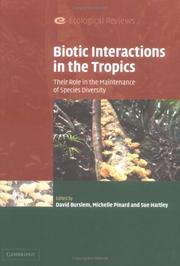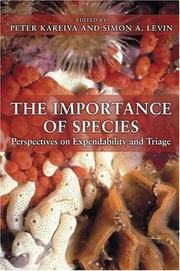| Listing 1 - 8 of 8 |
Sort by
|
Book
ISBN: 0191668346 0191810088 1299467016 0191668338 9780191668333 9781299467019 9780199569342 0199569347 Year: 2013 Publisher: Oxford
Abstract | Keywords | Export | Availability | Bookmark
 Loading...
Loading...Choose an application
- Reference Manager
- EndNote
- RefWorks (Direct export to RefWorks)
One of the most interesting and vexing problems in ecology is how distinctly different communities of plants and animals can occur in the same ecosystem. The theory of these systems, known as multiple stable states, is well understood, but whether multiple stable states actually exist in nature has remained a hotly debated subject. Multiple Stable States in Natural Ecosystems provides a broad and synthetic critique of recent advances in theory and new experimental evidence. Modern models of systems with multiple stable states are placed in historical context. Current theories are covered in a
Biotic communities. --- Species diversity. --- Diversity, Species --- Richness, Species --- Species richness --- Biodiversity --- Biocenoses --- Biocoenoses --- Biogeoecology --- Biological communities --- Biomes --- Biotic community ecology --- Communities, Biotic --- Community ecology, Biotic --- Ecological communities --- Ecosystems --- Natural communities --- Ecology --- Population biology
Book
ISBN: 9780521709637 9780521883184 0521709636 0521883180 9780511815683 9780511719264 0511719264 9780511514975 0511514972 0511815689 9786612539152 6612539151 0511738226 1107200148 1282539159 0511718810 0511718357 0511516258 Year: 2009 Publisher: Cambridge : Cambridge University Press,
Abstract | Keywords | Export | Availability | Bookmark
 Loading...
Loading...Choose an application
- Reference Manager
- EndNote
- RefWorks (Direct export to RefWorks)
Bringing together the viewpoints of leading ecologists concerned with the processes that generate patterns of diversity, and evolutionary biologists who focus on mechanisms of speciation, this book opens up discussion in order to broaden understanding of how speciation affects patterns of biological diversity, especially the uneven distribution of diversity across time, space and taxa studied by macroecologists. The contributors discuss questions such as: Are species equivalent units, providing meaningful measures of diversity? To what extent do mechanisms of speciation affect the functional nature and distribution of species diversity? How can speciation rates be measured using molecular phylogenies or data from the fossil record? What are the factors that explain variation in rates? Written for graduate students and academic researchers, the book promotes a more complete understanding of the interaction between mechanisms and rates of speciation and these patterns in biological diversity.
ECO Ecology --- biodiversity --- speciation --- evolutionary biology --- Diversité des espèces --- 575.858 --- Species. Speciation --- 575.858 Species. Speciation --- Diversité des espèces --- Biodiversity --- Species diversity --- Diversity, Species --- Richness, Species --- Species richness --- Biodiversité --- Species diversity. --- Biodiversity. --- Biological diversification --- Biological diversity --- Biotic diversity --- Diversification, Biological --- Diversity, Biological --- Biology --- Biocomplexity --- Ecological heterogeneity --- Numbers of species
Book
ISBN: 1616684062 9781616684068 9781616683436 1616683430 9781616684068 Year: 2010 Publisher: New York : Nova Science Publishers,
Abstract | Keywords | Export | Availability | Bookmark
 Loading...
Loading...Choose an application
- Reference Manager
- EndNote
- RefWorks (Direct export to RefWorks)
Species diversity. --- Biodiversity conservation. --- Extinction (Biology) --- Animals --- Extirpation (Biology) --- Biology --- Extinct animals --- Biodiversity --- Biological diversity conservation --- Conservation of biodiversity --- Diversity conservation, Biological --- Gender mainstreaming in biodiversity conservation --- Maintenance of biological diversity --- Preservation of biological diversity --- Conservation of natural resources --- Ecosystem management --- Diversity, Species --- Richness, Species --- Species richness --- Extinction --- Extirpation --- Conservation
Book
ISBN: 3960675801 9783960675808 396067080X 9783960670803 Year: 2017 Publisher: Hamburg, [Germany] : Anchor Academic Publishing,
Abstract | Keywords | Export | Availability | Bookmark
 Loading...
Loading...Choose an application
- Reference Manager
- EndNote
- RefWorks (Direct export to RefWorks)
Conservation biology. --- Species diversity. --- Endangered species. --- Endangered animal species --- Endangered animals --- Endangered wildlife --- Threatened animal species --- Threatened animals --- Threatened species --- Threatened wildlife --- Vanishing species --- Vanishing wildlife --- Wildlife, Endangered --- Wildlife, Threatened --- Wildlife, Vanishing --- Species --- Wildlife conservation --- Rare animals --- Diversity, Species --- Richness, Species --- Species richness --- Biodiversity --- Ecology --- Nature conservation

ISBN: 0521847079 0521609852 9780521609852 9780521847070 9780511541971 051154197X 9780511128011 0511128010 0511127480 9780511127489 1107152607 1280434902 9786610434909 051120017X 0511182538 0511300603 Year: 2005 Publisher: Cambridge : Cambridge University Press,
Abstract | Keywords | Export | Availability | Bookmark
 Loading...
Loading...Choose an application
- Reference Manager
- EndNote
- RefWorks (Direct export to RefWorks)
Tropical ecosystems house a significant proportion of global biodiversity. To understand how these ecosystems function we need to appreciate not only what plants, animals and microbes they contain, but also how they interact with each other. This volume, first published in 2005, synthesises the state of knowledge in this area, with chapters providing reviews or case studies drawn from research conducted in both Old and New World tropics and including biotic interactions among taxa at all trophic levels. In most chapters plants (typically trees) are the starting point, but, taken together, the chapters consider interactions of plants with other plants, with micro-organisms and with animals, and the inter-relationships of human-induced disturbance with interactions among species. An underlying theme of the volume is the attempt to understand the maintenance of high diversity in tropical regions, which remains one of the most significant unexplained observations in ecological studies.
Ecology --- Biotic communities --- Species diversity --- Ecologie --- Ecosystèmes --- Diversité des espèces --- ECO Ecology --- biodiversity --- ecology --- plant-animal relationships --- tropical forests --- tropical regions --- 574.4 --- Terrestrial biocoenoses and ecosystems. Biogeocoenoses. Biogeochemical cycles. Food chains --- 574.4 Terrestrial biocoenoses and ecosystems. Biogeocoenoses. Biogeochemical cycles. Food chains --- Ecosystèmes --- Diversité des espèces --- Diversity, Species --- Richness, Species --- Species richness --- Biodiversity --- Biocenoses --- Biocoenoses --- Biogeoecology --- Biological communities --- Biomes --- Biotic community ecology --- Communities, Biotic --- Community ecology, Biotic --- Ecological communities --- Ecosystems --- Natural communities --- Population biology
Book
ISBN: 0128237686 9780128237687 9780128097274 Year: 2021 Publisher: London, England : Academic Press,
Abstract | Keywords | Export | Availability | Bookmark
 Loading...
Loading...Choose an application
- Reference Manager
- EndNote
- RefWorks (Direct export to RefWorks)
Ecology --- Biogeography. --- Species diversity --- R (Computer program language) --- Bayesian statistical decision theory. --- Multilevel models (Statistics) --- Mathematical models. --- Mathematical models --- Regression analysis --- Hierarchical linear models (Statistics) --- Mixed effects models (Statistics) --- Random coefficient models (Statistics) --- Variance component models (Statistics) --- Statistical decision --- Bayes' solution --- Bayesian analysis --- Biology --- Geography --- Areography (Biology) --- Geographical distribution of animals and plants --- Species --- Species distribution --- Domain-specific programming languages --- GNU-S (Computer program language) --- Biodiversity --- Diversity, Species --- Richness, Species --- Species richness --- Geographical distribution

ISBN: 0691090041 069109005X 1400866774 132257216X 9781400866779 9780691090047 9780691090054 Year: 2003 Publisher: Princeton : Princeton University Press,
Abstract | Keywords | Export | Availability | Bookmark
 Loading...
Loading...Choose an application
- Reference Manager
- EndNote
- RefWorks (Direct export to RefWorks)
A great many species are threatened by the expanding human population. Though the public generally favors environmental protection, conservation does not come without sacrifice and cost. Many decision makers wonder if every species is worth the trouble. Of what consequence would the extinction of, say, spotted owls or snail darters be? Are some species expendable? Given the reality of limited money for conservation efforts, there is a compelling need for scientists to help conservation practitioners set priorities and identify species most in need of urgent attention. Ecology should be capable of providing guidance that goes beyond the obvious impulse to protect economically valuable species (salmon) or aesthetically appealing ones (snow leopards). Although some recent books have considered the ecosystem services provided by biodiversity as an aggregate property, this is the first to focus on the value of particular species. It provides the scientific approaches and analyses available for asking what we can expect from losing (or gaining) species. The contributors are outstanding ecologists, theoreticians, and evolutionary biologists who gathered for a symposium honoring Robert T. Paine, the community ecologist who experimentally demonstrated that a single predator species can act as a keystone species whose removal dramatically alters entire ecosystem communities. They build on Paine's work here by exploring whether we can identify species that play key roles in ecosystems before they are lost forever. These are some of our finest ecologists asking some of our hardest questions. They are, in addition to the editors, S.E.B. Abella, G. C. Chang, D. Doak, A. L. Downing, W. T. Edmondson, A. S. Flecker, M. J. Ford, C.D.G. Harley, E. G. Leigh Jr., S. Lubetkin, S. M. Louda, M. Marvier, P. McElhany, B. A. Menge, W. F. Morris, S. Naeem, S. R. Palumbi, A. G. Power, T. A. Rand, R. B. Root, M. Ruckelshaus, J. Ruesink, D. E. Schindler, T. W. Schoener, D. Simberloff, D. A. Spiller, M. J. Wonham, and J. T. Wootton.
575.858 --- Species. Speciation --- 575.858 Species. Speciation --- Conservation biology. --- Species diversity. --- Endangered species. --- Biodiversity conservation. --- Biodiversity --- Biological diversity conservation --- Conservation of biodiversity --- Diversity conservation, Biological --- Gender mainstreaming in biodiversity conservation --- Maintenance of biological diversity --- Preservation of biological diversity --- Endangered animal species --- Endangered animals --- Endangered wildlife --- Threatened animal species --- Threatened animals --- Threatened species --- Threatened wildlife --- Vanishing species --- Vanishing wildlife --- Wildlife, Endangered --- Wildlife, Threatened --- Wildlife, Vanishing --- Diversity, Species --- Richness, Species --- Species richness --- Conservation --- Biodiversity conservation --- Endangered species --- Species diversity --- Conservation biology --- Ecology --- Nature conservation --- Species --- Wildlife conservation --- Rare animals --- Conservation of natural resources --- Ecosystem management
Book
ISBN: 1316236153 1316255077 1316253171 1316249395 1316251284 1316234266 1139794744 131624749X 9781316247495 9781139794749 9781316249390 9781107037656 1107037654 Year: 2015 Publisher: Cambridge : Cambridge University Press,
Abstract | Keywords | Export | Availability | Bookmark
 Loading...
Loading...Choose an application
- Reference Manager
- EndNote
- RefWorks (Direct export to RefWorks)
The development of molecular tools has dramatically increased our knowledge of parasite diversity and the vectors that transmit them. From viruses and protists to arthropods and helminths, each branch of the Tree of Life offers an insight into significant, yet cryptic, biodiversity. Alongside this, the studies of host-parasite interactions and parasitism have influenced many scientific disciplines, such as biogeography and evolutionary ecology, by using comparative methods based on phylogenetic information to unravel shared evolutionary histories. Parasite Diversity and Diversification brings together two active fields of research, phylogenetics and evolutionary ecology, to reveal and explain the patterns of parasite diversity and the diversification of their hosts. This book will encourage students and researchers in the fields of ecology and evolution of parasitism, as well as animal and human health, to integrate phylogenetics into the investigation of parasitism in evolutionary ecology, health ecology, medicine and conservation.
Pathogenic microorganisms. --- Virulence (Microbiology) --- Microbial virulence --- Pathogenic microorganisms --- Disease-causing microorganisms --- Micro-organisms, Pathogenic --- Pathogens --- Microorganisms --- Medical microbiology --- Parasites --- Species diversity. --- Host-parasite relationships. --- Pathogenic bacteria. --- Variation. --- Evolution. --- Phylogeny. --- Ecology. --- Bacteria, Pathogenic --- Disease germs --- Bacteria --- Bacterial diseases --- Medical bacteriology --- Host-organism relationships --- Host-pathogen relationships --- Parasite-host relationships --- Pathogen-host relationships --- Relationships, Host-parasite --- Parasitism --- Animal parasites --- Animals --- Epizoa --- Parasitic animals --- Parasitic organisms --- Pests --- Diversity, Species --- Richness, Species --- Species richness --- Biodiversity --- Genetic Variation. --- Parasites. --- Host-Parasite Interactions. --- Phylogeography --- Variabilité génétique. --- Relations hôte-parasite. --- Parasitologie. --- Virulence (microbiologie) --- methods. --- Évolution. --- Variétés. --- Genetic Variation --- Host Microbial Interactions --- Host Microbial Interactions.
| Listing 1 - 8 of 8 |
Sort by
|

 Search
Search Feedback
Feedback About
About Help
Help News
News